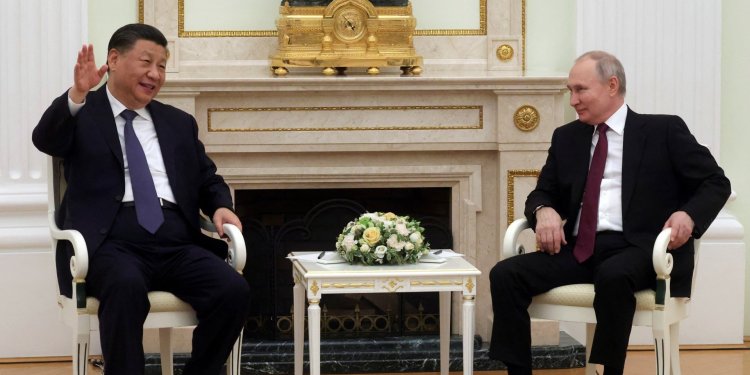In a three-day trip intended to strengthen ties between Beijing and Moscow and solidify. China’s position as a global power broker, Chinese President Xi Jinping is meeting with his Russian counterpart Vladimir Putin.
Putin reportedly stated that he views Xi’s 12-point peace plan with “respect” after helping to broker a detente between Saudi Arabia and Iran earlier this month. Xi is using the trip to promote the plan.
But, with Kyiv and Washington’s response to Xi’s peace offer being unenthusiastic. The Chinese president is more likely to be successful in advancing economic cooperation with Putin. However, which has intensified amid Moscow’s deepening isolation.
These are the main economic sectors where collaboration between Xi and Putin is most likely to increase.
While Western consumers have prohibited energy imports, China has emerged as a significant buyer of Russian oil and gas at steep discounts.
According to Chinese customs data, Russia was China’s top oil supplier in January and February with 1.94 million barrels per day, up from 1.57 million in 2022.
Furthermore increasing, Russia’s crude oil exports to China will increase by 8% to 1.72 million barrels per day in 2022.
Last year, China’s imports of liquefied natural gas and pipeline gas from Russia increased. By 2.6 times and 2.4 times, respectively, to $3.98 billion and $6.75 billion.
China’s imports of Russian coal, meanwhile, increased by 20% to 68.06 million tonnes.
In the face of sanctions, the booming oil sales have given Russia’s economy, which contracted by a less-than-expected 2.1 percent last year.
A much-needed lifeline. Aside from China, the two other major consumers of Russian energy are India and Turkey, both of whom have benefited from a harsh price cap on Russian oil to obtain cheaper energy.
Experts anticipate that sales will increase given the ongoing nature of the Ukrainian conflict.
A “no limits alliance” between China and Russia was announced just before Moscow invaded Ukraine. A large portion of that has shown up in trade.
Russia has increased its imports of Chinese commodities, such as machinery, electronics, basic metals, automobiles, ships, and airplanes, while selling energy to China.
Chinese customs records show that China’s exports to Russia increased to $76.12 billion in 2022 from $67.57 billion in the previous year.
Chinese businesses, including those in the auto industry, have benefited from a flight of Western brands from Russia.
Last year, Geely Automobile Holdings, Chery Automobile, and Great Wall Motor all captured 17% of the Russian market.
Overall, two-way trade increased by about a third last year to reach around $190 billion, and this growth is expected to continue. Yet, their economic ties are unbalanced.
According to customs data, although China is Russia’s most significant economic partner, commerce between the two countries is dwarfed.
By China’s trade with the United States, the European Union, and the Association of Southeast Asian Nations.
According to government statistics, trade between these top three trading partners in 2022 was valued at $947 billion, $821 billion, and $734 billion, respectively.
In a lengthy letter that was signed and published in the Russian Gazette before his visit to Moscow, Xi called for increased trade, investment, and economic cooperation.
Early on in the invasion of Ukraine, Western actions to freeze the assets of Russia’s central bank and commercial banks.
Disconnect Russian financial institutions from the SWIFT global payments network, and expel Western banks and credit card companies briefly damaged Russia’s economy.
The Chinese yuan and cryptocurrencies have filled the gap left by Russia’s exclusion from the dollar-dominated global financial system.
According to the Carnegie Endowment for International Peace, the proportion of yuan-based transactions increased from 0.4 percent to 14 percent of the total over a nine-month period.
Two Russian banks started lending in yuan in September, and they also switched from SWIFT to using the currency for money transfers.
Russia became the fourth-largest offshore trading hub for the yuan in October as a result of its increasing reliance on the Chinese currency.
In order to close budget deficits brought on by reduced oil and gas income. Russia’s central bank sold $47 million worth of yuan in January amidst depleting dollar reserves as a result of sanctions.
In a recent article for the Carnegie Endowment for International Peace, visiting fellow at the German Council on Foreign Relations. Alexandra Prokopenko stated that while switching from the dollar and euro to the yuan.
May be a successful short-term solution, it will increase Russia’s financial dependence on China.
“The de-dollarization of the economy, of which the Russian authorities are so proud, is really just another way of saying ‘yuanization.
Russia is moving away from its reliance on the dollar and toward a yuan currency zone, according to Prokopenko. This is hardly a trustworthy replacement because the People’s Bank of China.
And the Chinese Communist Party’s policies will now have an impact on Russian reserves and payments. If the two nations’ relations deteriorate, Russia could suffer reserve losses.















